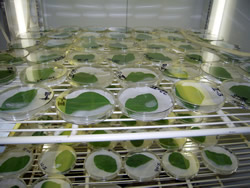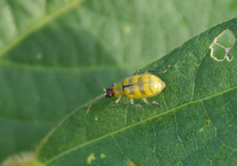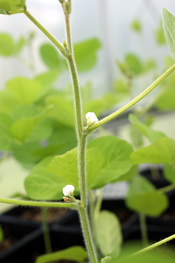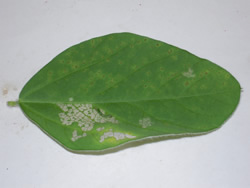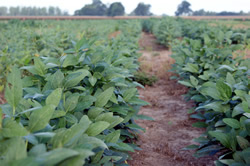Environmental Effects on Induced-Plant Resistance
For plants, interactions with herbivorous insects are well known to negatively impact fitness. As a consequence, plants are expected to have evolved defense strategies to reduce herbivore pressure. Often, plants utilize a constitutive defense strategy whereby defenses are expressed at all times. In unpredictable environments, however, plants can benefit from a defense strategy in which chemical or morphological defenses are mobilized (induced) only in response to herbivory. Although an inducible defense strategy is common in nature, it is largely unknown how the efficacy of an inducible response may be influenced by the identity of neighboring plants, that is, the community context. Plant community context can influence resistance of any one plant by affecting arthropod abundance and herbivory within a community. Therefore, neighbors can be an important factor in determining patterns of plant fitness.
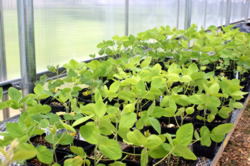
My MS student, Amanda Accamando, was interested in examining the efficacy of induced defenses in diverse communities. The main objective of her thesis research was to assess the costs and benefits of induced defenses for soybeans.
High genotypic variation in defense traits makes soybeans Glycine max) an ideal study system with which to evaluate how community variation in plant defense strategies influences herbivory and plant fitness. Because of its great agricultural importance, soybeans have been cultivated to express a wide variety of resistance traits to herbivore pests and pathogens.
Although costs and benefits of induced responses are generally assumed, empirical evidence for many species is lacking. Soybean (Glycine max L. Merr.) has emerged as a model species with which to address questions about induced responses. Amanda conducted the first study to examine the fitness costs and benefits of jasmonic acid-induced responses by soybean in the absence and presence of soybean loopers (Chrysodeix includens Walker) (Lepidoptera: Noctuidae) (Accamando and Cronin 2012). In a greenhouse experiment we demonstrated that soybean induction was costly. Induced plants produced 10.1% fewer seeds that were 9.0% lighter, and had 19.2% lower germination rates than noninduced plants. However, induction provided only modest benefits to soybeans. In a choice experiment, soybean loopers significantly preferred leaves from noninduced plants, consuming 62% more tissue than from induced plants. Soybean loopers that fed on plants that were previously subjected to treatment with jasmonic acid matured at the same rate and to the same size as those that fed on control plants. However, at high conspecific density, soybean looper survivorship was reduced by 44% on previously induced relative to control plants. Reduced soybean looper preference and survivorship did not translate into fitness benefits for soybeans. Our findings support theoretical predictions of costly induced defenses and highlight the importance of considering the environmental context in studies of plant defense.
